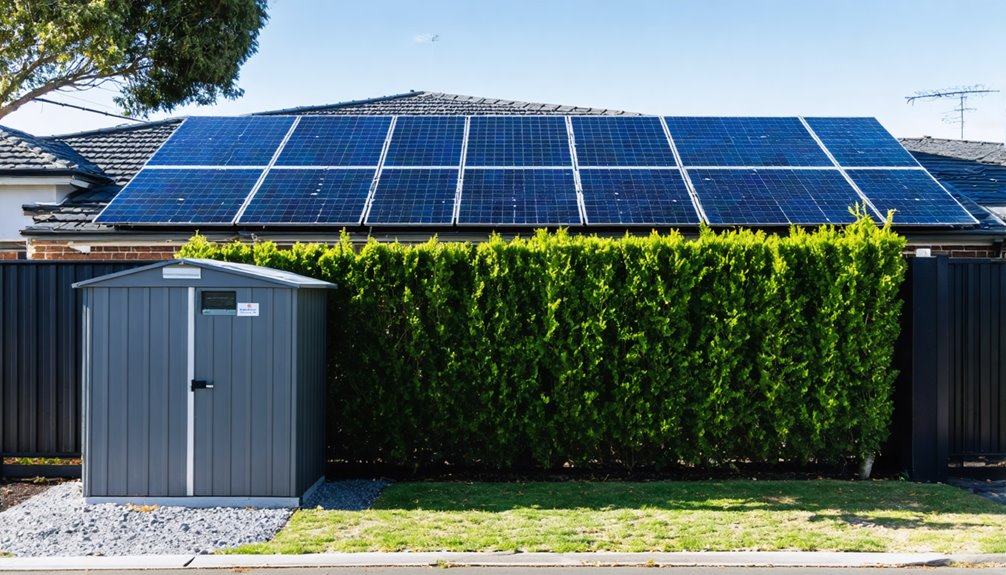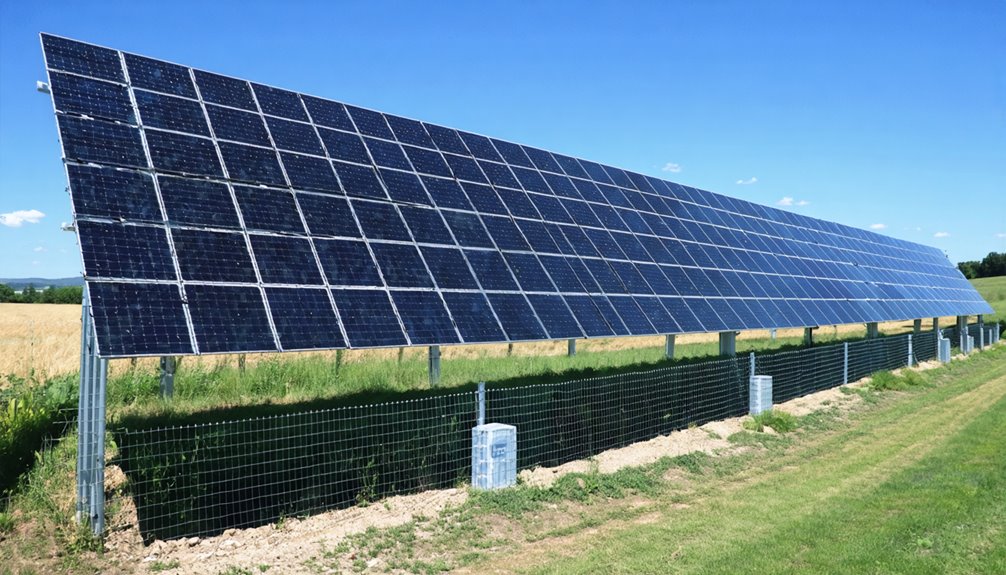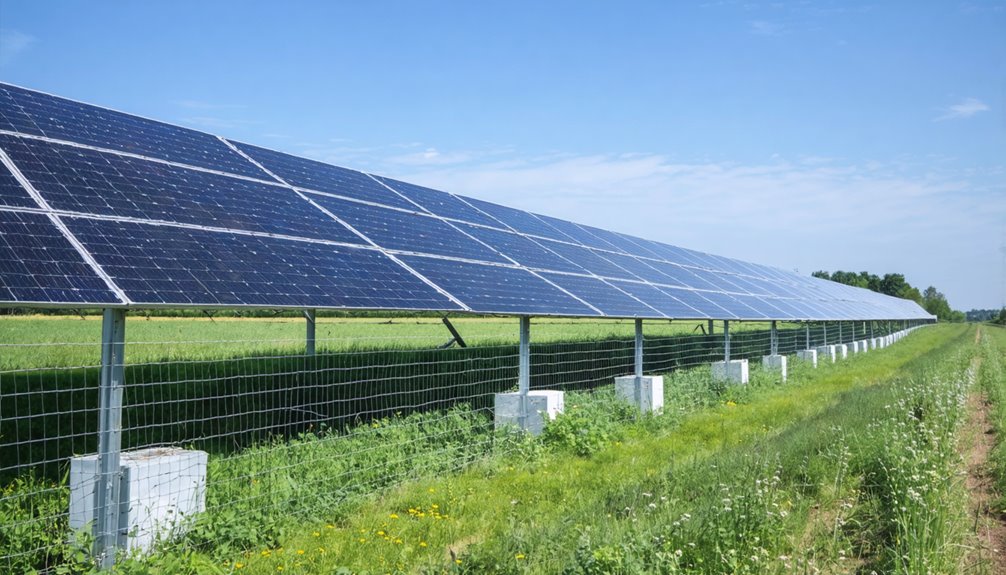Solar fence systems harness Vertical Bifacial Photovoltaic technology to turn your property’s boundaries into high-efficiency energy producers. These dual-sided solar panels excel in capturing daylight, ensuring up to 20% more energy output than conventional models, even in overcast conditions. With adjustable heights and robust galvanized steel frames, they provide supreme containment for livestock, while also reducing utility costs and increasing property value through potential tax incentives. Discover how they integrate into regenerative agriculture and promote energy independence.
Understanding Solar Panel Fencing
Incorporating advanced Vertical Bifacial Photovoltaic (VBPV) technology, solar panel fencing transforms traditional property boundaries into efficient, dual-sided solar energy collectors, allowing them to harness sunlight from both the front and back surfaces, thereby enhancing overall energy production. These solar panels, integrated into fencing structures, not only redefine property limits but also contribute considerably to renewable energy generation. The bifacial solar modules are designed to sustain 80% performance for 25-40 years, offering a reliable, long-term energy solution. Their innovative vertical design maximizes sunlight exposure, making them especially effective in dense urban environments and under winter conditions. Solar fence systems provide both security and privacy enhancement, as well as economic advantages, including potential access to government tax incentives and savings on electricity costs. Choosing the right mounting strategy also requires considering regional sun paths and maintenance needs, as appropriate tilt and azimuth influence yearly output tilt and azimuth.
Advantages of Vertical Bifacial Photovoltaic Technology
With Vertical Bifacial Photovoltaic (VBPV) technology, you can achieve enhanced daylight energy capture by utilizing dual-sided sunlight efficiency, allowing both sides of the panels to convert sunlight into electricity, greatly boosting their performance compared to traditional systems. This dual-sided approach not only maximizes energy generation during overcast or low-light conditions but also guarantees optimized seasonal performance, as panels can adjust to varying solar angles throughout the year. By incorporating these adaptive capabilities, VBPV installations provide you with a highly efficient and reliable energy solution, effectively leveraging their design to maintain consistent power output across different seasons and environmental conditions.
Enhanced Daylight Energy Capture
Although traditional solar panels have been the mainstay of solar energy collection, the advent of Vertical Bifacial Photovoltaic (VBPV) technology marks a new era in maximizing solar energy capture. A solar fence utilizing VBPV technology can capture sunlight on both sides of the panel, considerably enhancing energy production. By leveraging reflected light from the ground, this advanced design elevates energy output by up to 20% more than conventional solar panels. This increased efficiency is especially apparent in dynamic installations, where higher placements bolster resistance to environmental factors like wind or snow. Importantly, VBPV technology excels in winter, effectively capturing sunlight from various angles, ensuring energy consistency during cloudy conditions, and maintaining at least 80% performance for 25-40 years with durable engineered glass.
Dual-Sided Sunlight Efficiency
When considering the advantages of Vertical Bifacial Photovoltaic (VBPV) technology, it’s clear that dual-sided sunlight efficiency stands out as a critical benefit. Bifacial solar panels capture sunlight on both sides, allowing them to maximize energy production even in spaces where sunlight exposure may be limited. This innovative technology transforms traditional fencing by integrating energy-generating structures, thereby supporting renewable energy initiatives and reducing carbon footprints. Furthermore, higher installations of bifacial solar panels can markedly double energy output with only a minimal increase in installation costs, offering a compelling return on investment. They also guarantee 80% performance over 25-40 years, providing a long-term energy solution. By leveraging dual-sided sunlight efficiency, VBPV technology enhances sustainable energy generation on your property.
Optimized Seasonal Performance
As you explore the capabilities of Vertical Bifacial Photovoltaic (VBPV) technology, its ability to optimize seasonal performance emerges as a notable advantage. VBPV technology’s dual-sided design maximizes solar energy capture, harnessing sunlight from both sides, which considerably enhances energy production throughout varying seasons. This solar technology adapts well to environmental challenges, providing a dependable barrier against seasonal elements like wind, snow, dust, and noise, ensuring consistent performance. With fence heights between 6-10 ft, VBPV systems accommodate various agricultural needs, offering robust containment for livestock while benefiting from optimized seasonal performance. These bifacial solar panels guarantee long-term reliability and efficiency, delivering at least 80% output over a 25-40 year lifespan, supporting sustainable farming practices alongside multi-species regenerative rotational grazing.
Innovative Features and Design of Solar Fencing
You’re looking at solar fencing systems that ingeniously merge dual-purpose functionality with advanced solar technology, transforming property boundaries into both secure enclosures and efficient energy sources. These systems leverage Vertical Bifacial Photovoltaic (VBPV) technology to optimize energy capture from both sides of the panel, while the versatile structural design, featuring adjustable heights and galvanized steel frames, guarantees adaptability to various agricultural settings and species containment needs. With these innovative features, solar fencing not only reduces electricity bills but also enhances durability and security, lasting up to 40 years even in harsh weather conditions.
Dual Purpose Functionality
Solar fencing is revolutionizing property security and energy efficiency by seamlessly integrating cutting-edge Vertical Bifacial Photovoltaic (VBPV) technology into its design, effectively transforming traditional barrier systems into dual-purpose solutions that maximize functionality. By utilizing bifacial panels, these systems capture solar energy from both sides, doubling potential energy output without compromising fence strength. This approach supports adjustable heights from 4-10 ft, making solar fencing ideal for various needs, including multi-species regenerative rotational grazing. Wire mesh designs enhance security against predators, ensuring contained livestock and contributing to sustainable agricultural practices. Beyond security, solar fencing can remarkably reduce utility bills for homeowners, potentially qualifying them for government incentives, thereby increasing property value by reducing energy costs while offering robust perimeter control.
Advanced Solar Technology
Though often overshadowed by more traditional forms of energy collection, solar fencing‘s use of Vertical Bifacial Photovoltaic (VBPV) technology brings cutting-edge advancements to the forefront of renewable energy integration. This advanced solar technology captures sunlight from both sides, markedly boosting energy production efficiency compared to regular solar panels. The bifacial modules’ robust design guarantees operation at 80% performance for up to 40 years, allowing long-term energy generation. Adjustable orientations, in both landscape and portrait, accommodate various panel heights, from 3 to 10 feet, to balance aesthetic appeal and practical use in different agricultural settings. Besides energy generation, solar fences serve as privacy barriers and can qualify you for tax credits and savings on utility bills, aiding in carbon footprint reduction.
Versatile Structural Design
To address diverse agricultural requirements, solar fencing systems boast a versatile structural design that enables dynamic adjustment of fence and corral heights, ranging from 4 to 9 feet, thereby catering effectively to various containment needs. This adaptability guarantees solar fencing not only meets but exceeds essential security standards, offering a high level of security for properties. The integration of bifacial solar modules, capable of harnessing sunlight from both sides, enhances functionality by virtually doubling energy output without significant installation cost increases. These systems are further fortified with wire mesh solutions that accommodate a wide array of animal species, from bison to rabbits, and protect against predator intrusion. The aluminum series construction provides durability and a sleek appearance, while vertical bifacial photovoltaic technology optimizes sunlight capture.
Energy Efficiency and Cost Savings

By embracing the innovative approach of transforming property boundaries into energy resources, solar fencing systems enable property owners to achieve substantial energy efficiency and cost savings. These systems reduce utility bills by offsetting electricity usage, as bifacial solar panels maintain 80% performance for 25-40 years, ensuring dependable output. The vertical panel design maximizes sunlight capture, particularly during winter, resulting in ideal energy production and financial savings. This approach contributes to a reduced carbon footprint, aligning with sustainability goals and governmental clean energy initiatives. In addition, solar fencing may lead to tax credits and financial incentives, further enhancing property value. Serving dual functions, solar fences provide security while lowering operational energy costs, making them a sound long-term investment for homeowners seeking efficiency.
Integrating Solar Fencing With Regenerative Agriculture
With the energy efficiency and cost-saving benefits of solar fence systems clearly outlined, it’s compelling to explore how these technologies integrate seamlessly with regenerative agriculture. By harnessing solar energy, these systems empower regenerative rotational grazing, utilizing adjustable fence heights of 4-9 feet to contain diverse livestock, including bison, chickens, and rabbits, within the same paddock. The incorporation of bifacial solar modules doesn’t just enhance energy production; it also acts as a robust barrier, shielding against wind, snow, dust, and sound, thereby improving the environmental conditions for crops and animals. Integrating wire mesh enhances security from predators while enabling multi-species farming. Together, solar panels and fencing optimize land use, forming agrivoltaic systems that advance energy generation and support regenerative agriculture. Moreover, incorporating tracking systems can heighten energy production and support scalable agrivoltaic configurations within regenerative grazing systems.
Steps Towards Energy Independence and Sustainability
Although solar fence systems may initially seem like a simple boundary solution, they serve as a pivotal step towards energy independence and sustainability for property owners. By integrating bifacial solar technology, solar fences capture sunlight from both sides, which enhances energy production and reduces reliance on traditional utilities. The vertical panel design guarantees peak sunlight capture year-round, even in urban landscapes or winter months. Transforming property boundaries into energy resources, solar fencing offers the dual Benefits of Solar infrastructure—lowering utility costs and carbon footprints. Homeowners can leverage government tax credits and align with USDA clean energy initiatives, enhancing both property value and sustainable living goals. Selecting the optimal mounting approach with solar panel mounts can further enhance installation stability and energy capture.
| Benefit | Description |
|---|---|
| Enhanced Energy Output | Captures sunlight from both sides of the panels. |
| Cost Reduction | Lowers utility bills and qualifies for tax credits. |
| Sustainability | Reduces CO2 emissions, supporting clean energy. |
| Urban Efficacy | Effective in city environments, even in winter. |
Key Considerations for Installing Solar Fencing

When initiating the installation of solar fencing, several critical factors must be taken into account to confirm peak performance and durability. Consider the height and orientation of solar panels, as they can range from 3-7 feet tall in landscape or portrait orientations, affecting energy production and functionality. Opt for bifacial solar modules, which can perform up to 80% for 25-40 years, guaranteeing a heavy duty and long-lasting energy solution. Ascertain the sturdy build of the fencing structure, using galvanized steel mullions and crossbeams to meet high strength requirements against local snow and wind loads. Adding wire mesh can enhance containment and safety for agricultural purposes. Accessories, such as ground rods and digital battery meters, priced from $2.50, are essential for efficient system operation. Ballast mounting ballast mounting provides a non-penetrating solution for securing panels on flat roofs without drilling, using weighted blocks to hold frames in place.
Conclusion
Solar fence systems offer a practical approach to energy generation by utilizing vertical bifacial photovoltaic technology to improve property energy efficiency and reduce costs. These systems integrate well with regenerative agriculture practices while promoting energy independence and environmental sustainability. Successful implementation requires careful consideration of site orientation, local regulations, and shading factors to ensure optimal energy capture and system performance.
For property owners considering solar fence installations, proper mounting systems are essential for long-term performance and safety. Solocity Global serves as a trusted exporter of solar panel mounting systems, providing high-quality, standards-compliant mounting solutions to clients worldwide who seek reliable infrastructure for their renewable energy projects.


